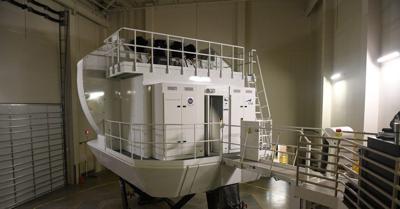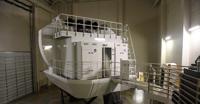GLENVILLE — The 109th Airlift Wing is getting a full-motion flight simulator that will allow air crews to practice arctic flight operations in Glenville rather than Greenland.
It’s a major upgrade in training capabilities for the unit, and one that will make Stratton Air National Guard Base a destination for crews that fly the four-engine C-130 cargo plane.
Its benefit will extend to the community, wing commander Col. Christian Sander said, with a small bump in the workforce at the base and increased bookings at area hotels.
More important, he said, it will expand training opportunities to the pilots, navigators and flight engineers of the 109th, which is the only unit in the world flying the LC-130, the ski-equipped version of the workhorse plane.
The simulator has the actual switches and instruments found in a real C-130, and computer algorithms that make it handle like the real plane would in a wide array of scenarios.
“This one’s a full-motion simulator, good 3D vision, kind of like IMAX,” Sander said. “It really does a great job.”
There are two parts to the project: Construction of a building and the infrastructure for it, which will be overseen in-house; and assembly and installation of the simulator itself, which will be done by the manufacturer.
Maj. Shawn Rulison, commander of the 109th Civil Engineer Squadron, said lining up contractors and permits is likely to take the rest of 2022. He hopes for a 2023 groundbreaking; construction of the 11,400-square-foot building will take about a year. Installation and setup of the simulator is expected to be complete in 2024.
The U.S. General Services Administration, in announcing the contract opportunity for construction of the building, estimated its cost in the $10 million to $25 million range.
Rulison said he couldn’t narrow down the price tag, particularly given the rapidly rising and widely fluctuating cost of construction. But funding was appropriated for the project and is in place, he said.
The building will include a two-story, 65-by-65-foot bay for the simulator, plus high-capacity electrical and climate-control systems and a separate room for the computers that will run it all.
The simulator looks nothing like a C-130 from the outside, but on the inside it is indistinguishable from the real thing, Rulison said. And it’s adaptable to varied needs, he added.
The original C-130A Hercules first flew as a prototype in 1954 and went into service in 1956; the current C-130J has been produced since 1998. Along the way, more than 70 variants have been produced, from tanker to gunship to polar ski bird.
It’s one of the most enduring aircraft designs of all time, spanning more than half the entire era of powered flight.
But each model and some of the variants are a little different from the previous. With the power of modern computers, a simulator can be programmed to match the idiosyncrasies of each one.
The simulator installed at Stratton will be switchable between the LC-130H and the C-130H, Rulison said.
The 109th is known for the LC-130H, which has retractable wheels for paved or dirt runways and skis affixed to its belly for snow and ice landings. But to save the ski birds from some of the wear and tear of training, the wing also flies the C-130H, which has only the retractable wheels.
The simulator facility to be built at Stratton will be future-compatible: If the 109th gets the LC-130J aircraft on its wish list, the structure will be able to accommodate the J-model simulator, Rullison said.
LC-130 crews on an Antarctic mission to support scientific research have a set of challenges different from most military aviators. Rather than flying into a combat zone, they’re potentially flying into some of the worst weather on the planet, sometimes zero-zero in a whiteout.
“We call it flying inside a ping pong ball,” Sander said.
Typically, the 109th will fly to Greenland to train for this, then sit and wait for a bad weather day for actual flight operations — all of which carries a cost in time, money, fuel and wear on the equipment and the people who operate it.
“What we will do with this simulator is we’ll put an Antarctica environment, a Greenland environment into it,” he said.
Nothing will fully replace actual flight training, Sander said, but the simulator is a good supplement, and the new model will allow the 109th to do it at home rather than in Arkansas, Minnesota or Georgia, where it has been traveling in recent years for its simulated flight hours.
When the simulator is up and running, Stratton will likely take on the role of host, Sander added, possibly running the machine in two shifts.
“I do expect other C-130 bases to wind up coming here and doing some of their annual training,” he said.
Realistic training extends beyond the cockpit for the 109th. It’s developing a virtual reality and distance learning program for its maintenance crews to train for routine repairs in conjunction with facilities half a continent away.
There’s also the FuT.
The Fuselage Trainer was a worn-out C-130 at the end of its usable life. Instead of being ferried to the boneyard, it was stripped of wings and engines, and airlifted to Stratton. The power tailgate still works, so for purposes of sitting on the ground, it’s a viable classroom — loadmasters, firefighters and others can train on it without putting scratches and dents on an airworthy plane.
“That was a homegrown initiative here at the base,” Sander said, pushed along by some ambitious loadmasters, the crew in charge of whatever passengers and material the LC-130 is carrying.
All of this comes down to safety and performance.
There are real-life emergencies that are too risky to deliberately initiate in the air for sake of practice, Sander said, such as a multiple engine failure. But they’re fair game in a simulator.
“Usually they throw a bunch of scenarios at you,” he said.
Beautiful flying weather gradually turns ugly, then a high crosswind develops, then an engine shuts down, all courtesy of the programmer in the control booth. They can even run more-serious in-air emergencies, such as both engines on one wing shutting down.
The entire crew in the simulator’s pod has to perform just as they would if they were over open ocean, right down to their communication with the base.
“Every aspect of what you might have to do, you still have to do in the simulator,” Sander said.
As a career C-130 pilot, Sander finds a few gaps in simulators: The peripheral vision and seat-of-pants feel aren’t quite equal to the actual flying experience. But the electrical pistons under the pod do a fine job of mimicking the C-130’s movements in flight, he said, fooling the pilot’s inner ear into believing the sensations of shifting balance.
When the flight crew walks out of the simulator and back into their distinctive red-tailed LC-130s, they’re a little better prepared for the real-life versions of those computer-generated crises.









